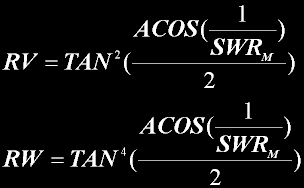Transmission line
|
SWR Conversion |
Nonlinear Converters
|
swrconv |
proc |
far |
;convert swrw to |
|
|
push |
bp |
|
|
mov |
bp,sp |
|
|
Conversion of VSWR for the broadcaster to a practical unit... |
|
Transmission line |
the problem: "wave-measure"
Vi= Voltage of the incident or forward wave.|
graph of SWR=(1+R)/(1-R) SWR ("Wave-measure") |
|
"It is the spirit and not the form of law that keeps justice alive."
- Earl Warren |
 RV is the voltage ratio.
RV is the voltage ratio. Power (wattage) is easily treated by simply squaring the VOLTAGE reading.
Power (wattage) is easily treated by simply squaring the VOLTAGE reading.|
|
SOLVING THE EQUATION...

Equation from trig. |

FLIP trigEquation |

|

|
|
|

|

|
My conversion formula RV=Ratio (in volts) |